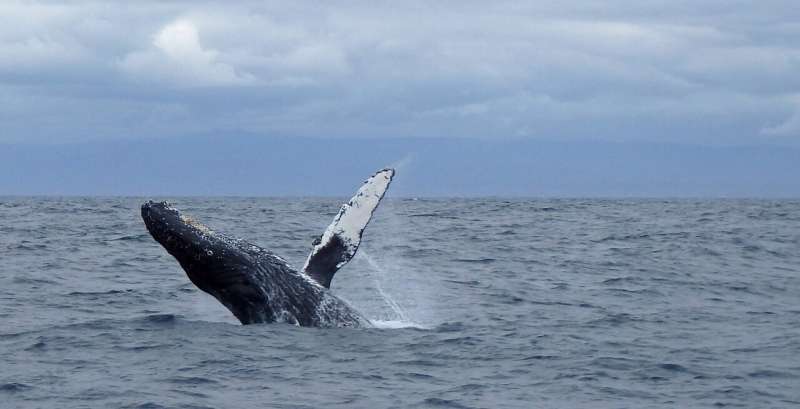
While three whales washing up on Hampton Roads beaches in three days is unusual, it is likely indicative of a long-term trend seen along the East Coast.
Gib Brogan, campaign director for Oceana, said the recent deaths are “not normal by any means,” but Virginia isn’t alone in experiencing humpback and minke deaths. Oceana is an international organization based in Washington focused on ocean conservation, including whale safety in the United States.
“There has been a string of humpback whale deaths, stretching from Florida up to Maine and then in the eastern Canada, stretching back a number of years,” Brogan said.
“So this is part of a longer multi-year trend, and (NOAA Fisheries) is looking into this and and trying to find a connection between these. Where they have been able to find the cause of death of the humpback whales, so far, it has been either from vessel strikes—being hit by a boat going by—or entanglement with fishing gear.”
On March 3rd, the first whale washed up in Virginia Beach in the resort area. Identified as a young humpback, the whale garnered attention from about 200 people as scientists worked to move it up the shore for a necropsy. According to a spokesperson from the Virginia Aquarium and Marine Center, which has a response team for stranded animals, the necropsy for the first whale had no obvious signs for a cause of death. The next day, a second humpback whale was spotted off the coast of False Cape State Park before washing onto the shore.
According to NOAA, elevated humpback whale mortalities have occurred since 2016. In Virginia, 31 humpback whale deaths were recorded on and off shore since January 2016. North Carolina reportedly had 28. Location represents the nearest state to where the confirmed mortality was first observed and does not necessarily reflect the location of the death of the animal.
About half of the humpback whales found washed up on the East Coast had full or partial necropsies, and NOAA reports that 40% had evidence of human interaction, either a ship strike or entanglement. Others had evidence for a vessel strike before they died, but NOAA reported that more research is needed.
“What we’ve seen in a number of cases with humpbacks is that they are chasing in the schools of smaller fish,” Brogan said.
“They’re following them into these areas where they have not been in the past, and because there are abundant food sources for the whales—one scientist told me that they’re so fat and happy and following the buffet of food—they’re swimming into dangerous areas and maybe not behaving as they normally would. It’s a tragic story, but in some ways, it’s a success story because those fish (populations) have been rebuilt, and there are there are lots of food items for those whales. We need to recognize these threats and do what we can to minimize them.”
In Corolla, a minke whale was found on the beach. A necropsy for that whale has not begun since the minke whale has washed back into the sea, according to officials Wednesday. It may take a few days for the whale’s body to bloat and come back into the shore, or it may be eaten by other animals while out in the ocean.
Like humpbacks, minke whales are also facing an unusual mortality event. Since 2017, 164 have been stranded on the East Coast. In Virginia and North Carolina, there have been 14 over the past six years. Necropsies done on about 60% of stranded minke whales showed that human interaction and infectious disease could be the biggest causes of death, but NOAA reported that more research is needed.
Winter is a popular time for whales in Hampton Roads, mainly humpbacks. Juvenile whales tend to hang out off the coast of Virginia Beach, as adult whales head south for breeding toward the Dominican Republic. Upwards of 300 different humpback whales have been identified by whale watchers in Hampton Roads, and it’s common to see some whales multiple years in a row.
Brogan said more needs to be done to protect whale species from vessel strikes and other human-caused issues. One way to curb deaths is speed restrictions, which NOAA has proposed for boats 35 feet and longer to hit the brakes during certain times of the year to help protect the highly endangered North Atlantic right whale.
“The government has a strong proposal out to update the speed zones in the U.S. Atlantic. That will reduce the risk that large whales will be hit by boats,” Brogan said. “This was done for North Atlantic right whales, for those critically endangered whales, but will undoubtedly have benefits for smaller whales, or other large whale species like humpbacks.”
2024 The Virginian-Pilot. Distributed by Tribune Content Agency, LLC.
Citation:
Here’s what conservationists say is likely causing the mysterious whale deaths along East Coast (2024, March 7)
retrieved 7 March 2024
from https://phys.org/news/2024-03-conservationists-mysterious-whale-deaths-east.html
This document is subject to copyright. Apart from any fair dealing for the purpose of private study or research, no
part may be reproduced without the written permission. The content is provided for information purposes only.







